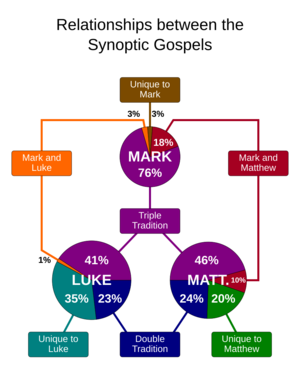Synoptic Gospels facts for kids
The New Testament includes four important books called gospels: Matthew, Mark, Luke, and John. Three of these—Matthew, Mark, and Luke—tell many of the same stories about Jesus in a very similar way. Because they are so alike, they are called the synoptic gospels. The word "synoptic" means "seeing together" or "from a similar point of view." The Gospel of John also shares some stories, but its writing style and focus are quite different from the other three.
The synoptic problem is a puzzle for Bible scholars. It asks: Why are Matthew, Mark, and Luke so similar in their stories, order, and even exact words, while John is so different? Understanding this helps us learn how these important books were written.
Contents
Exploring the Synoptic Problem
Many ideas try to explain why the synoptic gospels are so similar. Scholars have studied these texts for centuries to find the best answer.
Why Are the Gospels So Alike?
The strong similarities among Matthew, Mark, and Luke suggest they might have used common sources. It's like three friends writing about the same event, but two of them used the same notes or even copied parts from each other.
- One idea is that there was an older, common text that is now lost. Matthew, Mark, and Luke might have all used this one original source.
- Another idea suggests that early "evangelists" (people who told the stories of Jesus) learned the texts by heart. They would then share these stories when asked, leading to similar versions.
The Two-Source Theory
One of the most popular ideas is called the Two-Source Theory. This theory suggests that:
- The Gospel of Mark was written first.
- Matthew and Luke both used Mark's Gospel as a main source.
- Matthew and Luke also used another shared source, which scholars call "Q" (from the German word Quelle, meaning "source"). This "Q" source is believed to be a collection of Jesus's sayings that is now lost.
- Besides Mark and Q, Matthew and Luke also added their own unique stories and teachings that came from other sources they had access to.
Other Ideas for Similarities
Another idea is the Two-Gospel Hypothesis. This theory suggests that Matthew was written first, then Luke used Matthew, and finally Mark used both Matthew and Luke. This helps explain why Matthew and Luke share some things that are not found in Mark. However, the Two-Source Theory is generally more accepted by scholars today.
The fact that Matthew and Luke often agree on details that are not in Mark supports the idea of a shared source like "Q." It's a fascinating puzzle that helps us understand the early history of the Christian faith.
Images for kids
-
The calming of the storm is recounted in each of the three synoptic gospels, but not in John.
See also
 In Spanish: Evangelios sinópticos para niños
In Spanish: Evangelios sinópticos para niños





